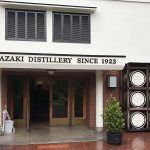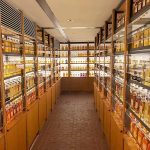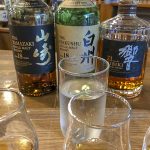Talk to the typical person who’s a fanatic about Japanese whiskey and you’ll hear a level of reverence that few other spirits ever receive. It is a veneration that is difficult to put into words. There is just something about Japanese whiskey that makes it different, that makes it special.
The story of Japanese whiskey is well-known, in part because compared to the rest of the world it is so young. Single malt wasn’t distilled in Japan until the Yamazaki distillery came online in 1923, when Masetsaka Taketsuru returned from Scotland with the secret sauce firmly locked in his brain. Since then, Japan has taken all of its cues from the Scots, and the similarities can be so striking that a novice drinker will often assume that Japan is simply trying to copy its progenitor to the west.
But let’s peel back the veneer a bit. There are some major differences between the two regions and their approach. This owes in part to significant differences in climate, but one of the less-talked-about changes is in the world of blending—specifically, in the way that barrels are chosen and blended together in order to create a final product.
How to Make a Japanese Whiskey
The occasional single-barrel release notwithstanding, nearly all whiskey is blended, the product of multiple barrels and often the product of multiple distilleries being mingled together with the idea of creating a finished product that is greater—and more complex—than the sum of its parts.
Dominic Roskrow, author of the seminal Whisky Japan, reminds us that this has long been the case in Scotland, where distilleries have freely traded casks for centuries in order to add complexity to their finished products. “Scotland has a smorgasbord of flavors to choose from,” said Roskrow, which is why any given bottle of Scotch can be a deep dive into the flavor wheel.
But that’s not the case in Japan, where collaboration is virtually unheard of. “For the first few years of the Whisky Live show,” said Roskrow, “they couldn’t even get Nikka and Suntory to sit on the same stage together.” The traditions of Japanese business dictate that secrecy is king. “There’s a suspicion to the way the Japanese approach everything, really,” he said. “Any information you give out can be used against you.”
Nonetheless, Japan has long sought to emulate Scotland, where a typical blend or blended malt might have up to 40 whiskeys in the mix. Given that Japanese distillers can’t rely on their neighbors for barrels, what do they do? They make a boatload of different whiskeys themselves, all in-house.
“Japan has the most complex distilleries on the planet,” Roskrow said. “In a typical distillery, you’ll find any number of pot and column stills, all different shapes and sizes. They also have a large number of yeast strains to work with. Every day they mix up the production process—double distilled, triple distilled, combinations of different pot and column stills and using different yeasts. The result is that a single distillery can produce 50 to 60 different spirits in-house.” From there, those spirits can go into a multitude of cask types, each of which can be aged for a variable amount of time—the upshot being that a distillery like Nikka or Suntory will ultimately have hundreds or thousands of aged spirits, all different from one another, which they can blend and bottle.
In the Lab at Nikka and Suntory
The approach at Nikka Whisky Distilling falls largely in line with Roskrow’s observations, but the depth of its blending strategy is far deeper than you might imagine, according to Tadashi Sakuma, Nikka Whisky chief blender, and Naoki Tomoyoshi, Nikka Whisky international business development representative, who responded to interview questions jointly via email.
“In the case of developing a new product,” say Sakuma and Tomoyoshi, “first we picture the aromas and flavors required for the new product. Then from the thousands of lots of whisky we choose the candidates for the product, make a formula and blend. We repeat this process until the product matches what we first pictured. The formula is finalized through consumer research and fine-tuning. In the case of updating an existing formula, the most important thing is the consistency in taste profile and quality. When we run out of a particular batch of whisky used in a product, we then have to replace it with something else. We choose a batch that has a similar profile to the one that is gone and repeat the experiment until the taste profile and quality matches the original formula.”
That’s a basic blending story that you might hear anywhere, but the magic at Nikka is in the use of “sub-blends,” vattings of smaller numbers of whiskeys that represent an intermediate step between single barrels and finished products. Say Sakuma and Tomoyoshi, “Nikka has many different sub-blends, actually more than the number of products we have. These are like the pieces of a puzzle. We stabilize the quality at the sub-blend stage to create consistency in the final products. In the case of a new product we will look into different combinations of sub-blends or create a new sub-blend to develop a new flavor profile. Since Nikka produces various types of whiskies within one distillery, the characteristics of the sub-blends are very diverse.”
Nikka is a rarity in Japan in that it has two different distilleries, Yoichi and Miyagikyo, which it can leverage to bring even more variety into its blends. Yoichi and Miyagikyo, for example, both have different “sherry-type” sub-blends that the blenders can use apart or together when creating new products. “Currently we have a few thousand different lots of whisky,” Sakuma and Tomoyoshi say. “Some may be an experimental batch created by a blender in the past; planting ‘seeds’ for the future is a part of the blender’s role.”
Sakuma and Tomoyoshi add, “The blender’s role is not just to blend. We examine the characteristics of our whiskies and check the quality of our new-makes. We are also responsible for developing whiskies and spirits with new aroma profiles. All this eventually leads to the actual, physical blending process. This is how our approach to blending differs from others… and is what makes us honored to be a blender (sic) at Nikka Whisky.”
That may sound awfully ephemeral, but Sakuma and Tomoyoshi note that blending is serious stuff. Is it art or science? “Creating flavors and harmony for a product can be called art,” they say, “however, creating the characteristic of each component whisky is science.”
The philosophy and general approach to blending is unsurprisingly about the same at archrival Suntory, where combinations of grains, stills and barrel types allow the distillery to produce over 150 different styles of spirit from which to blend.
Gardner Dunn, senior ambassador for Suntory Whisky, said that Suntory takes blending so seriously that it employs a team of five blenders who each are tasked with sampling 220 to 250 whiskeys every day. “They’re constantly checking each other to find the perfect casks for each blend,” he said. To keep their palates and environments clean, blenders are not allowed to smoke and are not allowed to eat garlic.
Blending is so serious here, said Dunn, that Seiichi Koshimizu, Suntory’s former chief blender, would eat the same meal for lunch every day, so as not to disrupt his palate. His successor, Shinji Fukuyo, follows the same practice.
Japanese Blending Goes West
More than 4,000 miles away in Seattle, Westland Whiskey Distillery is taking its cues from Japan, though blender Shane Armstrong didn’t exactly realize it when he first took the job as the distillery’s first full-time blender in late 2016. Armstrong said he developed his own sub-blending strategy independently, though the similarities are striking.
“I do a sub-blend approach,” he said, “but it’s on a bit of a smaller scale, mostly working in the lab. For our core range, I look for the main flavor components, then I build sub-blends and use them as building blocks to make a final blend. The idea is that in a batch of dozens of casks, I can quickly sub out four or five in the blend to see how things behave.”
Armstrong describes the technique as “stacking,” building batches of four barrels, then batching two of those together into an eight-barrel batch, then two of those into a 16-barrel batch and so on. He’ll take three batches of 32 barrels each, looking for flavors that are unique to one of them, then deconstruct them until he finds the single barrel that is responsible for creating the anomaly. Armstrong can then decide for which of Westland’s products that barrel (and batch) is best suited or determine what cask is ideal for the specific notes he wants in a given blend.
Like Nikka, Westland currently has 30 unique spirit types and 47 unique cask types to work with, making for over a thousand possible combinations.
“There’s no real whiskey-blending school,” said Armstrong, “so I learned this all as I went. I’m always tweaking my approach, but a lot of it is just keeping track of what I’m doing. I’m constantly looking at notes, asking what are the commonalities between blends and determining patterns in where certain casks are going.”
When Blending Is Too Successful
Blending is critical in any distillery that works with aged stock, but it has become increasingly crucial in an era that has seen age statements rapidly disappearing.
In Japan, rampant demand has driven stocks of older whiskeys down to nearly nothing, to the point where almost all the brands Nikka now markets have no age statement. Suntory has slowly been following suit. No Age Statement (NAS) whiskeys let these distilleries keep their brands alive—but only as long as consumers feel that the quality remains high. The upshot is that blenders are now under unprecedented pressure to choose the right casks and blend in the right quantities to keep customers from revolting.
In Japan, that strategy is working, at least for now. Said Roskrow, “I think Japan’s approach to NAS whiskey is surpassing Scotland’s approach to NAS, and that’s largely due to its blending strategy.”
“But,” he adds, “if you have blends as good as Hibiki, I think those are powerful weapons.”














